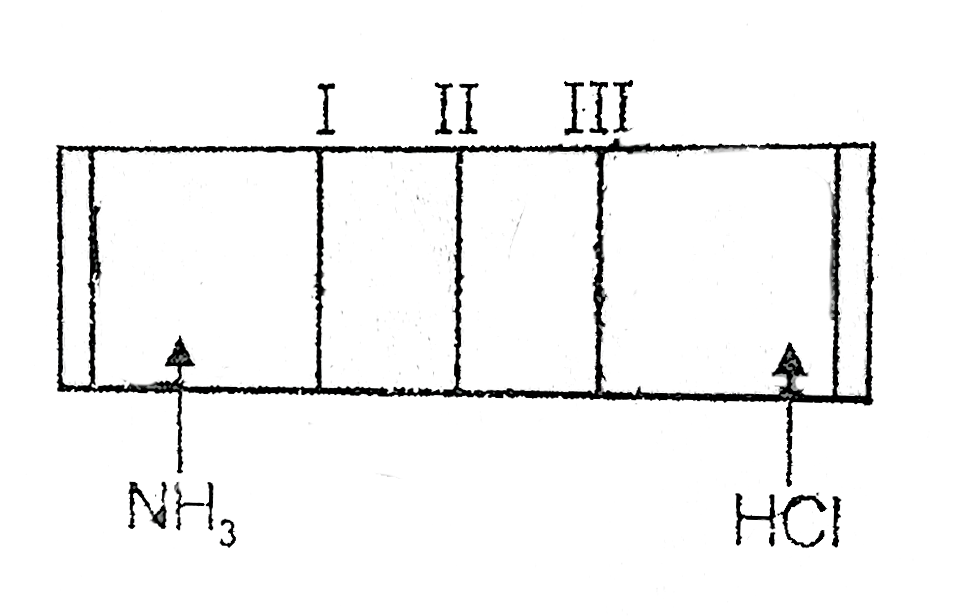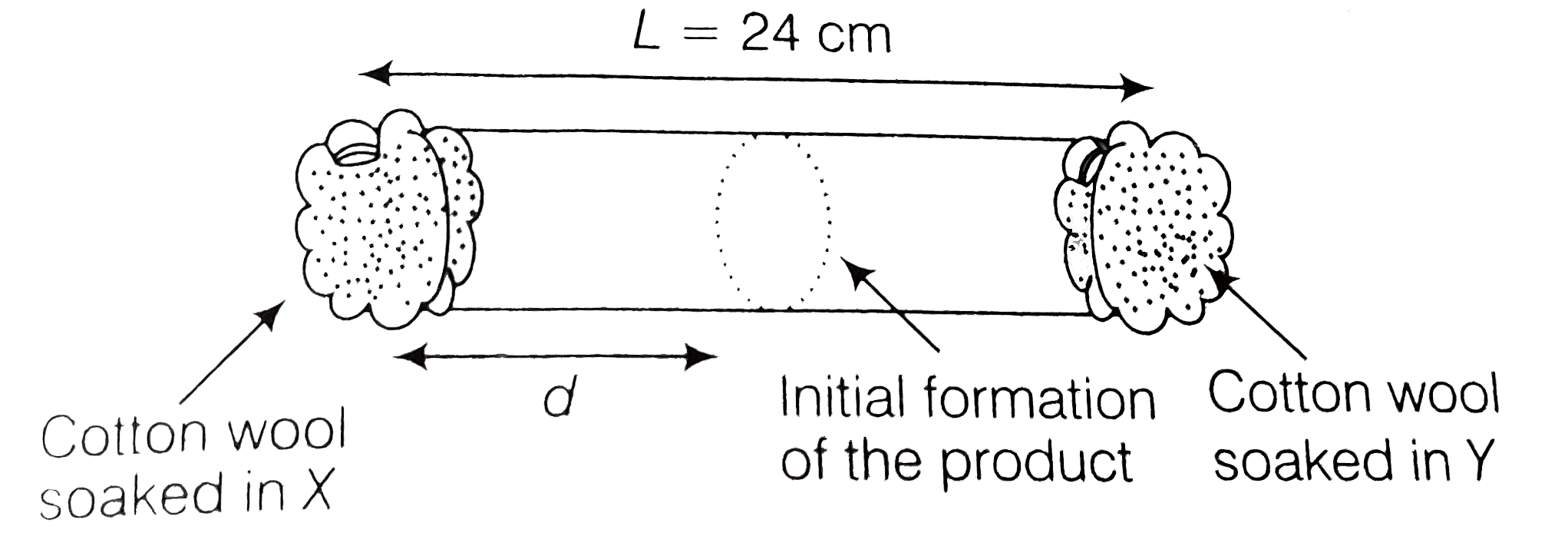Two pieces of cotton wool soaked separetely in aqueous solution of and HCl are placed at opposite ends of a close glass tube as shown in diagram

Select nearest position where white solid is formed
I
II
III
White solid does not formed
The correct Answer is:C
Volatile nature of
Topper's Solved these Questions
Similar Questions
The reaction between gaseous NH3 and HBr produces the white solid NH4Br. Suppose that NH3 and HBr are introduced simultaneously into the opposite ends of an open tube that is 1 metre long. Where would you expect the white solid to form ?
View SolutionThe reaction between gaseous NH3 and HBr produces a white solid NH4Br. Suppose that NH3 and HBr are introduced simultaneously into the opposite ends of an open tube of 1 metre length. Where would you expect the white solid to form?
View Solution
Knowledge Check
X and Y are two volatile liquids with molar weights of 10gmol−1 and 40gmol−1 respectively. Two cotton plugs, one soaked in X and the other soaked in Y, are simultaneously placed at the ends of a tube of length L=24 cm, as shown in the figure.
The tube is filled with an inert gas at 1 atm pressure and a temperature of 300K. Vapours of X and Y react to form a product whichh is first observed at a distance dcm from the plug soaked in X.
Take X and Y to have equal molecular diameters and assume ideal behaviour for the inert gas and two vapours.

The value of d in cm (shown in figure), as estimated from Graham's law, isA8B12C16D20X and Y are two volatile liquids with molar weights of 10gmol−1 and 40gmol−1 respectively. Two cotton plugs, one soaked in X and the other soaked in Y, are simultaneously placed at the ends of a tube of length L=24 cm, as shown in the figure.
The tube is filled with an inert gas at 1 atm pressure and a temperature of 300K. Vapours of X and Y react to form a product whichh is first observed at a distance dcm from the plug soaked in X.
Take X and Y to have equal molecular diameters and assume ideal behaviour for the inert gas and two vapours.

The experimental value of d is found to be smaller than the estimate obtained using Graham's law. This is due toAlarger mena free path for X as a compared of that of YBlarger mean free path for Y as compared to that of XCincreased collision frequency of Y with the inert gas as compared to that of X with the inert gasDincreased collision frequency of X with the inert gas as compared to that of Y with the inert gasWhen two cotton plugs, one moistened with ammonia and the other with hydrochloric acid, are sumulataneously inserted into opposite ends of a glass tube 87.0 cm long, a white ring of NH4Cl forms where gaseous NH3 and gaseous HCl first come into contact.
NH3(g)+HCl(g)→NH4Cl(s)
At what distance from the ammonis-moistened plug does this occur?A51.7 cm from NH3 endB51.7 cm from HCl endC43.5 at mid pointDNone of these
The reaction between gaseous NH3 and HBr produces a white solide NH4Br. Suppose a small quantity of gaseous NH3 and gaseous HBr are introduced simultaneously into opposite ends of an open tube which is one metre long. Calculate the distance of white solid formed from the end which was used to introduce NH3
View SolutionX and Y are two volatile liquids with molar weights of 10gmol−1 and 40gmol−1 respectively. Two cotton plugs, one soaked in X and the other soaked in Y, are simultaneously placed at the ends of a tube of length L=24 cm, as shown in the figure.
The tube is filled with an inert gas at 1 atm pressure and a temperature of 300K. Vapours of X and Y react to form a product whichh is first observed at a distance dcm from the plug soaked in X.
Take X and Y to have equal molecular diameters and assume ideal behaviour for the inert gas and two vapours.

The value of d in cm (shown in figure), as estimated from Graham's law, is
View SolutionX and Y are two volatile liquids with molar weights of 10gmol−1 and 40gmol−1 respectively. Two cotton plugs, one soaked in X and the other soaked in Y, are simultaneously placed at the ends of a tube of length L=24 cm, as shown in the figure.
The tube is filled with an inert gas at 1 atm pressure and a temperature of 300K. Vapours of X and Y react to form a product whichh is first observed at a distance dcm from the plug soaked in X.
Take X and Y to have equal molecular diameters and assume ideal behaviour for the inert gas and two vapours.

The value of d in cm (shown in figure), as estimated from Graham's law, is
View SolutionThe reaction between gaseous NH3 and HBr produces a white solide NH4Br. Suppose a small quantity of gaseous NH3 and gaseous HBr are introduced simultaneously into opposite ends of an open tube which is one metre long. Calculate the distance of white solid formed from the end which was used to introduce NH3
View SolutionWhen two cotton plugs, one moistened with ammonia and the other with hydrochloric acid, are sumulataneously inserted into opposite ends of a glass tube 87.0 cm long, a white ring of NH4Cl forms where gaseous NH3 and gaseous HCl first come into contact.
NH3(g)+HCl(g)→NH4Cl(s)
At what distance from the ammonis-moistened plug does this occur?
View Solution
